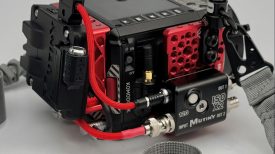The One LUT for Apple Log is a new LUT developed by Australian filmmakers Paul Henri and James Ballard specifically for the iPhone 15 Pro series when shooting Apple Log. Now, this isn’t actually new and it has been out since late last year.

The whole premise behind the LUT is that when you apply it to the iPhone 15 Pro series Log video it will match the ARRI K1S1 Rec709 look. It is interesting that they chose to go with the ARRI K1S1 Rec709 LUT, which is actually called the ALEXA Classic 709 LUT in modern ARRI cameras, instead of the more updated ARRI 709 LUT. The ARRI 709 LUT has increased contrast in the shadows and midtones and the shadows are cleaner with less saturated colors. I imagine that maybe because of the Apple Log curve, that the ARRI K1S1 Rec709 look may have been better suited than the newer LUT.
I don’t usually tend to post articles about LUTs because there are a lot of snake oil salesman ones out there, amongst a few good ones. I thought this one was worth mentioning because Apple Log could be a relatively new concept for a lot of users of an iPhone and they may not necessarily know how to deal with the footage. While Apple does have its own standard Rec709 look for Apple Log it is very saturated, and it features a very aggressive curve that isn’t overly flattering to skin tones.
With Apple Log offering around 12 stops of dynamic range, Henri and Ballard set out to see how closely they could match Apple Log to ARRI Alexa.
The LUT (Look-Up Table) they came up with after extensive testing is claimed to deliver beautiful skin tones and emulate ARRI’s world-renowned color response.
Creating this type of LUT prior to the arrival of the iPhone 15 Pro and 15 Pro Max wasn’t possible due to the limitations of previous models where digital sharpening and dynamic tone-mapping couldn’t be turned off. With the iPhone 15 Pro and 15 Pro Max it can now be turned off.

The team profiled the ARRI Alexa Mini in a controlled studio setting against the iPhone 15 Pro Max in Apple Log. They then used these various comparisons to come up with the LUT.

Above you can see some examples of what the One LUT looks like.
The new One LUT for Apple Log can be applied as a preview-only LUT or permanently burned into the final recording using the free Blackmagic Camera app for iOS. You can also use that same LUT within NLE and color grading programs such as DaVinci Resolve.
You can also see how to load the One LUT into the Blackmagic Camera App above.
Speaking of the Blackmagic Camera App, it allows you to actually burn a LUT into your footage, which is handy if you need to turn around something quickly or have no interest in color grading.
What you clearly need to remember with any LUT is it isn’t always going to give you the best results depending on what you are shooting. LUT should primarily be considered as viewing solutions when shooting and as a base for color grading or color correction. In saying that, for a lot of iPhone users they will just want to slap a Lot on the footage and call it a day.
Price & Availability
The One LUT for Apple Log is now available to be purchased from www.onelut.io for $25 USD.
Thoughts
While the One LUT is certainly going to help users of the iPhone 15 Pro and 15 Pro Max when they are shooting Apple Log, my question would be, why just make a LUT that is claimed to match an ARRI Alexa? Sure, if you are going to use an iPhone as a stand alone device it makes sense, but a lot of people are going to be using the iPhone as an extra angle or for the occasional pick up shot to insert with other camera footage. You could make a strong argument that it would have made more sense to develop LUTs for Apple Log that matched Sony S-Log3, Canon C-Log3, etc. as more people are likely to be using an iPhone in conjunction with mirrorless hybrids or more affordable digital cinema cameras than they are an ARRI Alexa.
Having a LUT that is claimed to match an Alexa isn’t necessarily going to be ideal if you are then trying to use iPhone footage with a Sony, Canon, Blackmagic, Panasonic, RED, etc.
None of this is meant to take away from the One LUT, because it looks to be a good solution, it is simply to raise points that people are likely to have.













